…is officially live! Check it out. Spread the word.
I want to draw special attention to the Gamer Theory TextArc in the visualization gallery – a graphical rendering of the book that reveals (quite beautifully) some of the text’s underlying structures.
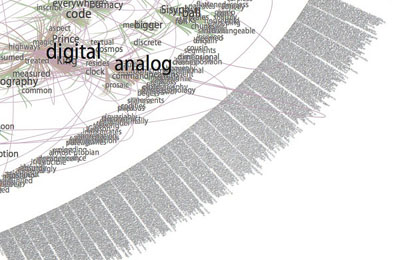
Gamer Arc detail
TextArc was created by Brad Paley, a brilliant interaction designer based in New York. A few weeks ago, he and Ken Wark came over to the Institute to play around with the Gamer Theory in TextArc on a wall display:
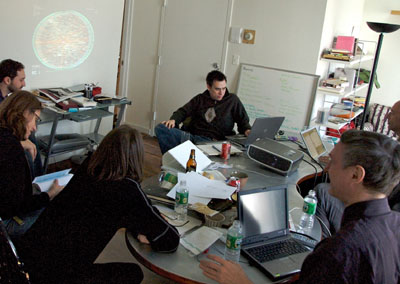
Ken jotted down some of his thoughts on the experience: “Brad put it up on the screen and it was like seeing a diagram of my own writing brain…” Read more here (then scroll down partway).

starting bottom-left, counter-clockwise: Ken, Brad, Eddie, Bob
More thoughts about all of this to come. I’ve spent the past two days running around like a madman at the Digital Library Federation Spring Forum in Pasadena, presenting our work (MediaCommons in particular), ducking in and out of sessions, chatting with interesting folks, and pounding away at the Gamer site — inserting footnote links, writing copy, generally polishing. I’m looking forward to regrouping in New York and processing all of this.
Thanks, Florian Brody for the photos.
Oh, and here is the “official” press/blogosphere release. Circulate freely:
The Institute for the Future of the Book is pleased to announce a new edition of the “networked book” Gamer Theory by McKenzie Wark. Last year, the Institute published a draft of Wark’s path-breaking critical study of video games in an experimental web format designed to bring readers into conversation around a work in progress. In the months that followed, hundreds of comments poured in from gamers, students, scholars, artists and the generally curious, at times turning into a full-blown conversation in the manuscript’s margins. Based on the many thoughtful contributions he received, Wark revised the book and has now published a print edition through Harvard University Press, which contains an edited selection of comments from the original website. In conjunction with the Harvard release, the Institute for the Future of the Book has launched a new Creative Commons-licensed, social web edition of Gamer Theory, along with a gallery of data visualizations of the text submitted by leading interaction designers, artists and hackers. This constellation of formats — read, read/write, visualize — offers the reader multiple ways of discovering and building upon Gamer Theory. A multi-mediated approach to the book in the digital age.
http://web.futureofthebook.org/mckenziewark/
More about the book:
Ever get the feeling that life’s a game with changing rules and no clear sides, one you are compelled to play yet cannot win? Welcome to gamespace. Gamespace is where and how we live today. It is everywhere and nowhere: the main chance, the best shot, the big leagues, the only game in town. In a world thus configured, McKenzie Wark contends, digital computer games are the emergent cultural form of the times. Where others argue obsessively over violence in games, Wark approaches them as a utopian version of the world in which we actually live. Playing against the machine on a game console, we enjoy the only truly level playing field–where we get ahead on our strengths or not at all.
Gamer Theory uncovers the significance of games in the gap between the near-perfection of actual games and the highly imperfect gamespace of everyday life in the rat race of free-market society. The book depicts a world becoming an inescapable series of less and less perfect games. This world gives rise to a new persona. In place of the subject or citizen stands the gamer. As all previous such personae had their breviaries and manuals, Gamer Theory seeks to offer guidance for thinking within this new character. Neither a strategy guide nor a cheat sheet for improving one’s score or skills, the book is instead a primer in thinking about a world made over as a gamespace, recast as an imperfect copy of the game.
——————-
The Institute for the Future of the Book is a small New York-based think tank dedicated to inventing new forms of discourse for the network age. Other recent publishing experiments include an annotated online edition of the Iraq Study Group Report (with Lapham’s Quarterly), Without Gods: Toward a History of Disbelief (with Mitchell Stephens, NYU), and MediaCommons, a digital scholarly network in media studies. Read the Institute’s blog, if:book. Inquiries: curator [at] futureofthebook [dot] org
McKenzie Wark teaches media and cultural studies at the New School for Social Research and Eugene Lang College in New York City. He is the author of several books, most recently A Hacker Manifesto (Harvard University Press) and Dispositions (Salt Publishing).
Category Archives: GAM3R_7H30RY
gamer theory 2.0 (beta)
The new Gamer Theory site is up, though for the next 24 hours we’re considering it beta. It’s all pretty much there except for some last bits and pieces (pop-up textual notes, a few explanatory materials, one or two pieces for the visualization gallery, miscellaneous tweaks). By all means start poking around and posting comments.
The project now has a portal page that links you to the constitutent parts: the Harvard print edition, two networked web editions (1.1 and 2.0), a discussion forum, and, newest of all, a gallery of text visualizations including a customized version of Brad Paley’s “TextArc” and a fascinating prototype of a progam called “FeatureLens” from the Human-Computer Interaction Lab at the University of Maryland. We’ll make a much bigger announcement about this tomorrow. For now, consider the site softly launched.
monkeys typing
Things are quiet here except for the soft patter of keyboards as we type/code/tweak away at Gamer Theory 2.0. The site goes live first thing Monday, at which point normal levels of conversation should resume. (Meanwhile, peaking out the window, it appears that spring has finally decided to arrive. Hallelujah!)
gamer theory update
Gamer Theory 2.0 is nearly there, we’re just taking a few extra few days to apply the finishing touches and to get a few last visualizations mounted in the gallery. The print edition from Harvard is available now.
For those of you in the city, there’s a great Gamer Theory event planned for tonight at the New School followed by drinks in Brooklyn at Barcade — a bar (as the name suggests) fitted out as a retro video game arcade (have a pint and play a round of Rampage, Gauntlet or Frogger). Here’s more info:
what: McKenzie Wark will present, and lead a discussion of his new book Gamer Theory (Harvard University Press). Jaeho Kang (Sociology, The New School for Social Reseach) will act as the respondent.
where: Wolff Conference Room, 2nd floor, 65 5th avenue (between 14th and 13th streets)
when: 6-8PM, Wednesday 18th April 2007
then: drinks & games at Barcade, 388 Union Ave Williamsburg (L train to Lorrimer st, take Union exit)
gamer theory 2.0 – visualize this!
Call for participation: Visualize This!
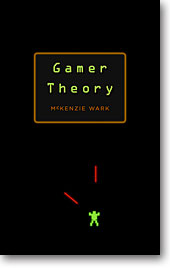 How can we ‘see’ a written text? Do you have a new way of visualizing writing on the screen? If so, then McKenzie Wark and the Institute for the Future of the Book have a challenge for you. We want you to visualize McKenzie’s new book, Gamer Theory.
How can we ‘see’ a written text? Do you have a new way of visualizing writing on the screen? If so, then McKenzie Wark and the Institute for the Future of the Book have a challenge for you. We want you to visualize McKenzie’s new book, Gamer Theory.
Version 1 of Gamer Theory was presented by the Institute for the Future of the Book as a ‘networked book’, open to comments from readers. McKenzie used these comments to write version 2, which will be published in April by Harvard University Press. With the new version we want to extend this exploration of the book in the digital age, and we want you to be part of it.
All you have to do is register, download the v2 text, make a visualization of it (preferably of the whole text though you can also focus on a single part), and upload it to our server with a short explanation of how you did it.
All visualizations will be presented in a gallery on the new Gamer Theory site. Some contributions may be specially featured. All entries will receive a free copy of the printed book (until we run out).
By “visualization” we mean some graphical representation of the text that uses computation to discover new meanings and patterns and enables forms of reading that print can’t support. Some examples that have inspired us:
- Brad Paley’s Text Arc
- Marcos Weskamp’s Newsmap
- Fernanda Viegas’ Wikipedia “History Flow”
- Chirag Mehta’s US Presidential Speeches Tag Cloud
- Kushal Dave’s Exegesis
- Magnus Rembold and Jurgen Spath’s comparative essay visualizations in Total Interaction
- Philip DeCamp, Amber Frid-Jimenez, Jethran Guiness, Deb Roy: “Gist Icons” (pdf)
- CNET News.com’s The Big Picture
- Visuwords online graphical dictionary
- Christopher Collins’ DocuBurst
- Stamen Design’s rendering of Kate Hayles’ Narrating Bits in USC’s Vectors
- Brian Kim Stefans’ The Dreamlife of Letters
- Young-Hae Chang Heavy Industries
Understand that this is just a loose guideline. Feel encouraged to break the rules, hack the definition, show us something we hadn’t yet imagined.
All visualizations, like the web version of the text, will be Creative Commons licensed (Attribution-NonCommercial). You have the option of making your code available under this license as well or keeping it to yourself. We encourage you to share the source code of your visualization so that others can learn from your work and build on it. In this spirt, we’ve asked experienced hackers to provide code samples and resources to get you started (these will be made available on the upload page).
Gamer 2.0 will launch around April 18th in synch with the Harvard edition. Deadline for entries is Wednesday, April 11th.
Read GAM3R 7H30RY 1.1.
Download/upload page (registration required):
http://web.futureofthebook.org/gamertheory2.0/viz/
do editors dream of electrifying networks?
Lindsay Waters, executive editor for the humanities at Harvard University Press, mentions the Gamer Theory “experiment” in an interview at The Book Depository:
BD: What are the principal challenges/opportunities you see at the moment in the business of publishing books?
LW: The principal challenge is that the book market is changing drastically. The whole plate techtonics is in motion. One chief challenge is not to get unnerved, not to believe Chicken Little as he runs up and down Main Street screaming “the sky is falling.” Books are not going to disappear. We have to experiment with the book which is what we are doing when, for example, we publish McKenzie Wark’s Hacker Manifesto and his forthcoming Gamer Theory.
Gamer Theory is a book that is already available on the web in electronic form, but we believe there is enough of a market for the print version of the book to justify our publishing the book in hardcover. This is an experiment.
One hopes the experimentation doesn’t end here. Last week, we had some very interesting discussions here on the evolution of authorship, which, while never going explicitly into the realm of editing, are nonetheless highly relevant in that regard. In one particularly excellent a comment, Sol Gaitan laid out the challenge for a new generation of writers, which I think could go just as well for a nascent class of digital editors:
…the immediacy that the Internet provides facilitates collaboration in a way no meeting of minds in a cafe or railroad apartment ever had. This facilitates a communality that approaches that of the oral tradition, now we have a system that allows for true universality. To make this work requires action, organization, clarity of purpose, and yes, a new rhetoric. New ways of collaboration entail a novel approach.
Someone is almost certainly going to be needed to moderate the discussions that come out of these complex processes, especially considering that the discussions themselves may consitute the bulk of the work. This task will in part be taken up by the author, and by the communities themselves (that’s largely how things have developed so far) but when you begin to imagine numerous clusters of projects overlapping and cross-pollinating, it seems obvious that a special kind of talent will be required to see the big picture. Call it curating the collective — redacting the remix. Organizing networks will become its own kind of art.
Later on in the interview, Waters says: “I am most proud of the way so many of my books constellate. I see these links in my books in literature, philosophy, and also in economics…” Editors have always been in the business of networks — the business of interlinking. More are now waking up to the idea that web and print can work productively, and even profitably, together. But this is at best a transitional stage. Unless editors reckon with the fact that the internet presents not just a new way of distributing texts but a new way of making them, plate techtonics will continue to destabilize the publishing industry until it breaks apart and slides into the sea.
small steps toward an n-dimensional reading/writing space
A few weeks ago, Mitch Stephens came to us with an interesting challenge: to design a social reading environment for a paper he will be presenting this Friday, Dec. 8 at a conference on religion and media at New York University. The paper, “Holy of Holies: On the Constituents of Emptiness”, is now live. This paper draws on the research Mitch has been doing for his book-length study of the history of atheism. It concerns the 1st century B.C.E. episode of the Roman general Pompey’s incursion into the tabernacle of the Second Temple. What he finds there… well, you’ll see. It’s a fascinating piece, which makes some interesting connections between belief systems and media systems, and it’s ready for your comments, annotations and criticims which you can post paragraph by paragraph through the text. It’s a new format that we’re playing with that could give new meaning to the idea of the “working paper.” We’re still fixing bugs and adding new features, but the basic apparatus is there. Take a look.
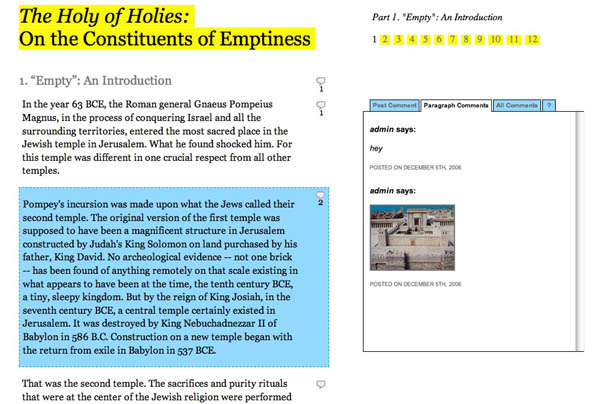
Over the past few months, Mitch has been moving out of the research stage and into full-on writing of his manuscript, and as a result he’s been thinking about workshopping larger chunks of text on his blog. This presents something of a quandary, however, as the short, pithy format of the blog, so good at sparking discussions generally, is not very good at dealing with longer expository texts. Earlier in November Mitch posted a draft of his book’s prologue with the hopes of getting substantive feedback from readers. The response was interesting but meager, largely owing to the fact that the discussion (on the blog) was so totally divorced from the actual text (a Word doc download). He had opted not to publish the prologue directly onto the site, since that would have meant breaking it up into multiple posts to create more points for commenting. This struck him as too clunky, especially considering the reverse-chronological order of the blog would necessitate posting the paper back to front. So he went with the download option. With his new paper he hoped to do something better, so he came to the Institute, or the “garage” as he calls it, to see if we could engineer a new approach.
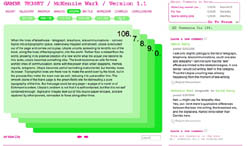 We had of course already done this with Gamer Theory. Our goal there had been to create a more richly interactive reading environment than was typically found in things broadly designated as “e-books,” an environment that offered multiple entry points for discussion and which placed reader input on roughly equal footing with the author’s text. This led to the deck of cards structure with comment areas to the side. Networked marginalia you might say, but far from marginal in its impact. As we had hoped/suspected, the discussion became a vital part of the book as a whole.
We had of course already done this with Gamer Theory. Our goal there had been to create a more richly interactive reading environment than was typically found in things broadly designated as “e-books,” an environment that offered multiple entry points for discussion and which placed reader input on roughly equal footing with the author’s text. This led to the deck of cards structure with comment areas to the side. Networked marginalia you might say, but far from marginal in its impact. As we had hoped/suspected, the discussion became a vital part of the book as a whole.
Now keep in mind that Ken submitted himself to a rigid rule set in writing his book: a uniform number of paragraphs per chapter (25), a strict word limit for paragraphs (250 or less), chapter titles in alphabetical order etc. In many ways, this made our design job easy. Just learn the rules and play the game. But it didn’t leave us with a tool that we could handily apply to other expository texts that are less consistently structured than Gamer Theory.
This experimental paper of Mitch’s is first stab at such a tool. Our solution was simply to give every paragraph (or block quote, or image) its own comment area. The commenting happens, as in Gamer Theory, alongside the text in the right margin but since the text isn’t broken up into cards, the comment area moves with you as you scroll down the page, changing its contents depending on which paragraph you’ve selected. It’s a small step, and although we’re pleased to be inching along toward better social document design, we’re painfully aware of the limitations, both technical and conceptual, that we have still to surmount.
Placing reader contributions alongside a text tends to involve breaking things up into columns, boxes and tabs, all of which are legacies of paper and print (not a crime in itself, but the point of this work is to move beyond simple mimicry of print into genuinely new structures for the electronic screen). In the digital environment, we can do nifty things like make boxes and columns overlap, hide areas of text behind other areas, or place windows within windows with multiple scrollbars, but we’re still thinking in two dimensions. We’re still thinking about the flat page. The question is, how many 2-D spaces can we layer together on a single flat plane before the whole thing collapses? How far can we hack Word Press before we rip open a worm hole that takes us to a reading/writing space where altogether different rules apply?
In October, a few of us went to see a fascinating panel (nominally on the topic of blogging, though it went off in various other directions) at the Hyperpolis conference at Brooklyn Polytechnic. It brought together a terrific lineup of internet theorists: Jodi Dean, Steven Shaviro, McKenzie Wark and Geert Lovink:
Ken showed Gamer Theory and discussed its successes and failures. On the one hand, he was delighted that we’d managed to build something that allowed readers to get intimately (and socially) involved with the text. On the other, he was dismayed that to do this we had to construct what Jodi Dean described as “a textual fortress,” a hyper-structured reading space with strictly prescribed parameters for reader participation (two types of input were permitted: paragraph-specific comments and general discussion in the forum). This is not to mention the other fortress-like attribute of the site: its brittleness. We built the site according to the blueprint of Ken’s manuscript, which made it prohibitively difficult to adapt to other texts, or even to accomodate revisions of restructuring of the present one.
If these forms are to be adaptable to a wider range of writing endeavors then we’ll need, in Ken’s words, “a new spatial architecture for dealing with text….like a nine-dimensional string theory space. An n-dimensional space is needed.”
I like this way of putting it, an n-dimensional space. And we’re still stuck on two. Social reading, collaborative authorship and multimedia are all introducing new variables, but at best we’re hovering somewhere just shy of 2.5 dimensions in our ability to design for these new conditions. Although… maybe a rich 2.5 is actually what we should be striving for, at least as far as text is concerned. If we venture into 3-D (into Second Life?), don’t we shed that degree of abstraction that is best suited for conceptual thought? 2.5 then, perhaps with flashes of three (like this zooming interface after Jef Raskin) for moving between texts in ways that explore the semantics of spacial relations. We’ll have to keep tinkering…
This is not to say that we’re not optimistic about where this modest experiment with Mitch’s paper might lead. We’re going to continue to develop this format and will be using it, or variations of it, for a number of projects in the near future. We’re also working on something that allows highly flexible line by line, even word-level, commentary. So go read Mitch’s thought-provoking paper, use the discussion areas, and tell us what works and what doesn’t, keeping in mind that this is a rough prototype that we threw together in a very short amount of time.
Kudos especially to Jesse for the beautifully understated design, and to Eddie for making such elegant pretzels out of the Word Press architecture. Thanks also to Jack Slocum, whose work was a great inspiration to us.
mckenzie wark on creative commons
Ken Wark is a “featured commoner” on the Creative Commons Text site in recognition of GAM3R 7H30RY, which is published under a CC Attribution-NonCommercial-NoDerivs 2.5 license. They’ve posted an excellent interview with Ken where he reflects on writing at the intersection of print and web and on the relationship between gift and commodity economies in the realm of ideas. Great stuff. Highly recommended.
Ken also traces some of the less-known prehistory of the Creative Commons movement:
…one of my all time favorite books is Guy Debord’s Society of the Spectacle. There’s a lovely edition for sale from Zone Books. Today its Amazon rank is about 18,000 – but I’ve seen it as high as 5,000. This edition has been in print for twelve years.
You can also get the whole text free online. In fact there are three whole translations you can download. In the ’60s Debord was editor of a journal called Internationale Situationiste. All of it is freely available now in translation.
The Situationists were pioneers in alternative licensing. The only problem was they didn’t have access to a good license that would allow noncommercial circulation but also bar unauthorized commercial exploitation. There were some terrible pirate editions of their stuff. Their solution to a bad Italian commercial edition was to go to the publisher and trash their office. There has to be a better way of doing things than that.
But in short: the moral of the story is that if you give a nice enough gift to potential readers, they return the gift by buying your stuff. Debord’s works are now classics. Constantly reprinted, a nice little earner for his widow. But it is because of this huge gift of stuff to readers that readers – generations of them – return the favor by buying the works.
Culture has always worked like that. The real question to ask is the reverse: how is anyone except the media conglomerates going to make a living when they have commodified culture to within an inch of its life? How are they even going to make a living off it? It’s never been done before in the history of the world.
The interview was actually done several months ago, before Ken had inked his deal with Harvard University Press, so a few sections regarding future prospects of the book are dated.
cs monitor on online books and collaborative writing
In which GAM3R 7H3ORY is discussed at length with some really smart comments by our own Jesse Wilbur. Also covered: Google’s new Docs & Spreadsheets online office suite, Wikipedia, and Larry Sanger’s Wikipedia offshoot, Citizendium.
pre-order Gamer Theory on amazon!
Yes, it’s coming. The official pub date is April 15, 2007 from Harvard University Press, and the Institute will be producing a new online edition in conjunction with the print release. Pre-order now!
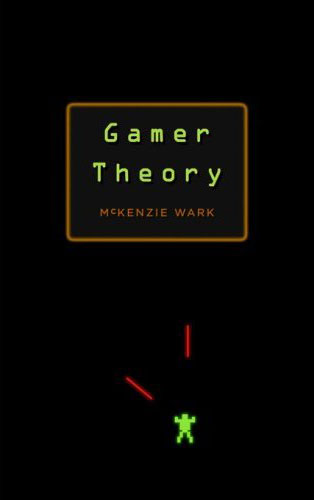
You’ll notice Ken’s dropped the L33T for the print title. He explains in a recent interview in RealTime:
For the website version I put the title in L33T [leet or gaming speak], partly in tribute to the early MUDs, but also to have a unique search string to put in Google or Technorati to track who was talking about it and where.
Smart. Also in that piece, a nice description of what we did:
As a critical engagement with the concepts of authorship, writing and intellectual property, GAM3R 7H30RY is a book written out of the social software fabric of blogs and wikis, Flickr, YouTube, Wikipedia and CiteULike. In other words, it represents a new writing practice that actively decentralizes the text as an object and disseminates it as an ongoing multi-channel conversation.
